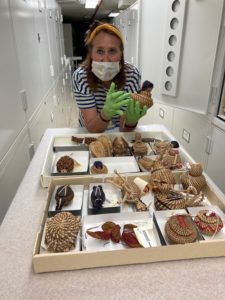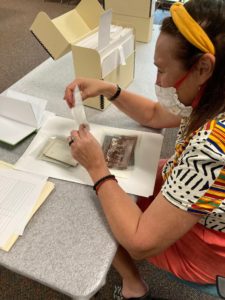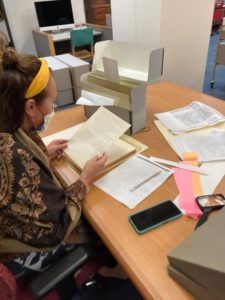Catching up with past NDSA Excellence Awards Winners – Arina Melkozernova
In 2021, Arina Melkozernova received the Future Steward award in recognition for her work and advocacy for “community-driven research that adopts Indigenous methodological and analytical frameworks” that contribute to “advancing knowledge across a variety of fields.” One project was the curation and translation in support of “A Journal of the Plague Year: An Archive of Covid-19,” created in response to the needs of Indigenous partners during the pandemic. Another project provided assistance to a partnership between Coushatta Tribal Archives and Arizona State University. Through this partnership she “explored new tools and software to help preserve, manage, and provide access to digitized material” and increase access to Coushatta history. Alongside archivists from the Coushatta Heritage Department, Arina worked with Mukurtu developers to create a site to ”satisfy the needs of a digital library, featuring important tribal governing documents, reports, photographs, maps,” and “shared herknowledge of best practices.”
Arina continues to advocate for and contribute to best practices that utilize Indigenous knowledge and methodologies. When we contacted her about her recent work at the Smithsonian, she offered the following responses.

1) What have you been doing since receiving an NDSA Excellence Award?
The NDSA award coincided with an invitation to join the “Mapping Traditional Knowledge and Land Use Practices among Southern Tribes/Leadership and Integrative Studies” project with the MOWA Tribal Band of Choctaw Indians led by Dr. Denise Bates. When I had a privilege to explore the Smithsonian collection as a SIMA fellow, I conducted an inventory of Koasati baskets and archival materials about Choctaw culture in the Museum Support Center. The two narratives arose from this data: one about everyday use of baskets made by weavers from the Coushatta Tribe of Louisiana and another – about the ecological resource usage preserved through the stories of the place of the Coushatta and MOWA Choctaw communities.
2) What did receiving the NDSA award mean to you?
I am thankful for the NDSA recognition of my modest efforts. The NDSA award made me aware of my responsibilities as a researcher and as a member of digital preservation community. The concept of the object’s biographies introduced during the SIMA fellowship combined with a non-western perspective on the baskets’ living properties afforded the opportunity to tell stories about basket weavers in a way that empowers their community and restores their spiritual connections with a place. It highlights the role of women in the tribal economy. The values of Object stories are in reconnection to the place because baskets are the “physical manifestation of knowledge our ancestors left to us. Our responsibilities to take care of the objects and learn from them” as Joe Horse Capture, second-generation indigenous curator, described (lecture, SIMA, June 27 2022)
The most crucial is to recognize that there are different knowledges. Kindly, allow me to tell my story from many years ago when I traveled to the Far East of Russia to do a fieldwork.
Imagine sitting in a shallow motor boat in the ocean surrounded by thick fog, so thick that you cannot see a palm of your hand in front of your face. You heard that this fog from rapidly melting icebergs could last for couple of weeks. Women and kids in the boat are crying fearing of drifting into the open sea without water or food. There I was, almost ready to graduate with my life science degree, completely disoriented and despaired. The fisherman on the boat saved our lives. He was Nivkh, the local indigenous person. He found the path to the land in zero visibility. The Nivkh fisherman had learned from his culture how-to navigate the surroundings that cannot be explained or framed with any oral language, only rest on this particular experience. I am here today because of this Nivkh fisherman’s skills and his knowledge of a sea navigation in extreme fog. Unfortunately, there is no technology to preserve certain embodied skills without supporting traditional lifestyle.
Although our data show that Coushatta and MOWA Choctaw communities are facing the common challenges to preserve their traditional lifestyle, my work is focused on translating the traditional knowledges and with technologies that are available today. For example, using the eco-geographical mapping method allows visualizing cultural intelligence and preserving community memories to secure the future of the next generations. Having guided by mentors access to searchable databases at the Smithsonian during the SIMA fellowship facilitated my ability to connect the baskets’ tangible and intangible qualities to the traditional knowledge embedded in them and to basket weavers, who embodied this entanglement.
3) What efforts/advances/ideas of the last few years have you been impressed with or admired in the field of data stewardship and/or digital preservation?
I see how the museum culture is changing to embrace non-Western knowledge systems. I appreciate the everyday efforts and baby steps that transforming the fields of anthropology and biology. I observe how the Smithsonian museum is becoming a meeting space to build allies. Their Repatriation Office collaborates with Native American, Alaska Native and Native Hawaiian tribal representatives. Multiple databases are searchable and accessible. I was
pleasantly surprised that herbariums are completely digitized! And some descriptions contain common names listed in native languages with English transcription! (Try to search for Abelmoschus moschatus Medik). However, the references to the traditional ecological knowledge is missing. This will be my next collaborative project.
4) How has your curation evolved since you won the Excellence Award?
I am grateful to Dr. Denise Bates, Museum Director Maggie Rivers, and the members of the MOWA Band of Choctaw Indians for the opportunity to prepare a collection of traditionally cultivated plants for the display in the MOWA Choctaw museum. To extend the narrative, I plan to analyze further in depth the ecological resource usage preserved through the stories of the place along with the traditional knowledge embedded in them. Data from the various documents from the National Archives that describes medicinal, sacred and nutritional qualities of source materials along with stories of plants gathered locally will be presented in Choctaw language. Every deliverable will be evaluated by the community and approved by the director of the museum.

5) What do you currently see as some of the biggest challenges in digital preservation?
As a non-indigenous researcher involved in collaborations with tribes, I see personal challenges that are common for the field of digital preservation. To become a Western interdisciplinary scholar, who supports involvement of indigenous knowledge holders in framing research questions, shaping analyses, and determining research instruments based on their assumptions, values, concepts, orientations, and priorities for co-producing results means to unlearn colonial gaze and relearn two-eye seeing. The biggest challenge is to set the rules for the knowledge sharing and decide on the format that is not harmful to the community. Making such decisions requires building the trust, which takes time. Following the principles of the community-driven participatory research support is important for arriving to a common space from which the collaboration between Indigenous scholars and TEK holders and Western scientists could emerge. In digital preservation field, the expectations are the same – respect, reciprocity and data sovereignty.
Reach out to Arina via her Twitter handle – @melkozernova
Read about other 2021 Excellence Awards winners here!
The post Catching up with past NDSA Excellence Awards Winners – Arina Melkozernova appeared first on DLF.
